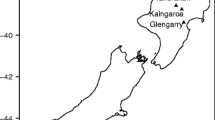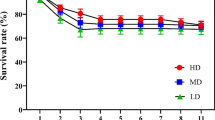Abstract
The success of silvopastoral systems depends to a large extent on the type of understory species used under particular site conditions. The effects of understory management on tree growth characteristics were investigated in an eight-year period in a silvopastoral agroforestry experiment in Canterbury, New Zealand. The period studied was from establishment (1990) to year eight (1998). The experiment included six understory treatments: 1) bare ground, 2) Maru phalaris (Phalaris aquatica L. cv. ‘Maru’) + clovers (Trifolium spp.), 3) Wana cocksfoot (Dactylis glomerata L. cv. ‘Wana’) + clovers, 4) Yatsyn perennial ryegrass (Lolium perenne L. cv. ‘Yatsyn’) + clovers, 5) Yatsyn perennial ryegrass, and 6) WL320 lucerne (Medicago sativa L. cv. ‘WL320’) and five radiata pine (Pinus radiata D. Don) genotypes. showed that tree height growth was mainly controlled by the genetic differences (genotypes) and was affected by understory competition to a lesser degree. Diameter growth was also affected by genetic differences and was significantly reduced by understory competition starting in year two. At the end of the eight-year period, diameter, basal area, and volume index in the most competitive understory treatment (lucerne) was only 81, 66, and 64% of that in the control (bare ground). Stem form and quality characteristics were also dependent on understory and genotype treatments, indicating the need for treatment specific evaluation when developing silvicultural prescriptions.
Similar content being viewed by others
References
Anderson L.S. and Sinclair F.L. 1993. Ecological interactions in agroforestry systems. Agrofor. Abstr. 6: 57-91.
Bandara G. 1997. Ecophysiology of Clonal and Seedling Trees of Pinus radiata D. Don in an Agroforestry System. Unpublished PhD thesis, Lincoln University, New Zealand. 153 pp.
Chang S.X., Amatya G., Beare M.H. and Mead D.J. 2002. Soil properties under a Pinus radiata-ryegrass silvopastoral system in New Zealand. Part 1. Soil N and moisture availability, Soil C, and tree growth.Agrofor. Syst. 54: 137-147.
Clarke A.L. 1997. The effect of understory pasture species on branch size and tree sinuosity in Pinus radiata at the Lincoln University agroforestry trial. M. Appl. Sci. dissertation. Lincoln University.
Clason T.E. and Sharrow S.H. 2000. Silvopastoral practices. In: Garrett H.E., Rietveld W.J. and Fisher R.F. (Eds.) North American Agroforestry: An Integrated Science and Practice, pp. 119-147. American Society of Agronomy, Madison, Wisconsin, USA.
Gautam M.K., Mead D.J., Chang S.X. and Clinton P.W. 2002. Spatial variation and understory competition effect of Pinus radiata fine roots in silvopastoral systems in New Zealand. Agrofor. Syst. 55: 89-98.
Hawke M.F. and Knowles R.L. 1997. Temperate agroforestry systems in New Zealand. In: Gordon A.M. and Newman S.M. (Eds.) Temperate Agroforestry Systems, pp. 85-118. CAB International, Wallingford, UK.
Kemp P.D., Matthew C. and Lucas R.J. 1999. Pasture species and cultivars. In: White J. and Hodgson J. (Eds.) New Zealand Pasture and Crop Growth, pp. 83-99. Oxford University Press, Auckland, New Zealand.
Maclaren J.P. 1993. Radiata pine grower's manual. FRI Bulletin No. 184. New Zealand Forest Research Institute, Rotorua, New Zealand. 140 pp.
Mason E.G. and Kirongo B. 1999. Response of radiata pine clones to varying levels of pasture competition in a semiarid environment. Can. J. For. Res. 29: 934-939.
Mead D.J. and Mansur I. 1993. Vector analysis of foliage data to study competition for nutrient and moisture: an agroforestry example. New Zealand J. For. Sci. 23: 27-39.
Mead D.J. 1995. The role of Agroforestry in industrialised nations: the southern hemisphere perspective with special emphasis on Australia and New Zealand. Agrofor. Syst. 31: 143-156.
Mead D.J., Lucas R.J. and Mason E.G. 1993. Studying interactions between pastures and Pinus radiata in Canterbury's sub-humid temperate environment-the first two years. New Zealand For. 38(1): 26-31.
Miller B.J., Clinton P.W., Buchan G.D. and Robson A.B. 1998. Transpiration rates and canopy conductance of Pinus radiata growing with different pasture understories in agroforestry systems. Tree Physiol. 18: 575-582.
Nambiar E.K.S. and Zed P.G. 1980. Influence of weeds on the water potential, nutrient content and growth of young radiata pine. Aust. For. Res. 10: 279-288.
Nambiar E.K.S. and Sands R. 1993. Competition for water and nutrients in forests. Can. J. For. Res. 23: 1955-1968.
Peri P.L., Mason E.G., Pollock K.M., Varella A.C. and Mead D.J. 2002. Early growth and quality of radiata pine in a silvopastoral system in New Zealand. Agrofor. Syst. 55: 207-219.
Pollock K., Lucas R.J., Mead D.J. and Thomson S.E. 1994. Forage-pasture production in the first three years of an agroforestry experiment. Proceedings of the New Zealand Grassland Association 56: 179-185.
Russelle M.P. 1992. Nitrogen cycling in pasture and range.J. Prod. Agric. 5: 13-23.
Schroth G. 1999. A review of belowground interactions in agroforestry, focusing on mechanisms and management options. Agrofor. Syst. 43: 5-34.
Squire R.O. 1977. Interacting effects of grass competition, fertilizing and cultivation on the early growth of Pinus radiata D. Don. Aust. For. Res. 7: 247-252.
Szott L.T., Fernandes E.C.M. and Sanchez P.A. 1991. Soil-plant interactions in agroforestry systems. For Ecol Manage 45: 127-152.
Tamm C.O. 1991. Nitrogen in Terrestrial Ecosystems: Questions of Productivity, Vegetation Changes, and Ecosystem Stability. Ecological Studies Vol. 81. Springer-Verlag, Berlin, Germany. 115 pp.
Yunusa I.A.M., Mead D.J., Pollock K.M. and Lucas R.J. 1995. Process studies in a Pinus radiate-pasture agroforestry system in a subhumid temperate environment. I. Water use and light interception in the third year. Agrofor. Syst. 32: 163-183.
Zobel B.J. and Talbert J.T. 1984. Applied Forest Tree Improvement. John Wiley & Sons Inc., New York, 505 pp.
Author information
Authors and Affiliations
Corresponding author
Rights and permissions
About this article
Cite this article
Chang, S.X., Mead, D.J. Growth of radiate pine (Pinus radiata D. Don) as influenced by understory species in a silvopastoral system in New Zealand. Agroforestry Systems 59, 43–51 (2003). https://doi.org/10.1023/A:1026137019822
Issue Date:
DOI: https://doi.org/10.1023/A:1026137019822




